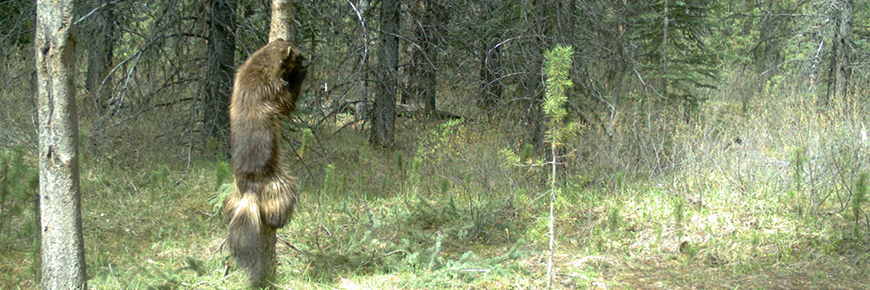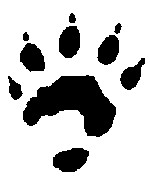
Wolverine
The wolverine is an enduring symbol of deep wilderness, dogged determination and fierce independence. Yet in Canada's Rocky Mountains, their numbers are few and threats to their habits and habitats are increasing. Found throughout high elevation forests and well into the harsh alpine, the wolverine covers a phenomenal amount of territory. But increasing human use in their habitat may leave this remarkable species at risk. Wolverines seek the same solitude and isolation desired by many backcountry visitors. Denning females with young are particularly vulnerable to disturbance from skiers and hikers.
Quick Facts
Weight: up to 18 kg (males) and up to 12 kg (females)
Diet: Once thought to be almost exclusively eaters of carrion, we now know they are accomplished predators. They will kill caribou, an animal several times their size. In summer, marmots and small mammals are the usual prey. In winter, most of their diet consists of large mammals such as mountain goats, moose and caribou that were previously killed by wolves or avalanches.
Status: Special Concern (SARA)

Background
The wolverine is the largest terrestrial member of the weasel family, collectively known as mustelids. Their relatives include weasels, mink, marten, fisher, badger and otters. They are truly a holarctic species, found across northern North America, Scandinavia and Russia. In North America, wolverines range as far south as California, but south of the boreal forest, they are only found in the most rugged mountain ranges, including Canada's Rocky Mountains.
The wolverine, particularly males which can be twice as big as females, is often mistaken for a small bear or a large hoary marmot. Close in size to a medium dog, males can weigh up to 18 kg, while females are as heavy as 12 kg. They have a rich, chocolate brown coat with blonde stripes down the sides. Individuals have unique silvery markings on their face, which is broad and large for the body size.
If you see a wolverine, consider yourself lucky, for they are few and far between. Researchers in British Columbia and Idaho estimate there is just one wolverine for every 150 to 300 km2. They cover a lot of ground in search of food and mates. In the far north, males may range over 3000 km2, an area as large as Kootenay and Yoho National Parks combined.
Here in the mountains, home ranges are smaller, typically 600 to 1000 km2 for males, but no less impressive when you consider the rugged terrain they must cross. Females, especially those with young, maintain a much smaller home range, generally less than 300 to 400 km2.
Diet
The wolverines' appetite is legendary. Their scientific name, Gulo, comes from the Latin word for glutton, but really they eat no more than any other animal their size. It's just that they aren't particularly picky eaters. They''re also remarkably adept at breaking into food caches and backcountry cabins, a behaviour that has earned wolverines almost demonic reputations with trappers.
Social behaviour
Other than females with kits, wolverines are solitary animals. Their lives may be best described as wandering mid- to high-elevation forests and alpine tundra in a continual search for food.
Mating occurs in May and June, but implantation is delayed until December or January, likely depending on the female's physical condition at the time. Poor nutrition caused by scarce food and increased stress from disturbances may impede a female from bringing a pregnancy to term. Come late winter, pregnant females move to higher elevations to den among large snow covered boulders or talus slopes, often in cirque basins, avalanche debris and windthrow. Here they raise a litter of 1 to 3 kits through the coming spring and summer. And it is here where this predator of renowned ferocity is most vulnerable.
Identifying wolverine tracks
- Wolverine track sequences are usually in sets of three prints, about the size of a large dog.
- Look closely at the middle print - it's actually made by two paws.
- Tracks may also be in sets of 4 (like lynx or wolf) or 2 (like fisher and marten).
- All five toes and claws are usually visible. Only four toes register for lynx (no claws) and wolf (claws visible) tracks.

Front
5th toe on front doesn't always show
Height: about 12 cm

Back
heel pad doesn't show on rear track
Height: about 10 cm
Conservation concerns
Despite their fearsome reputation, wolverines are susceptible to a number of disturbances. Denning females leave their young alone for up to several days while they search for food during the late winter. The young are helpless and vulnerable, so mothers ensure they are in a secure den, safe from potential predators. As a backcountry skier, you may unwittingly disturb a female with young kits, forcing her to find a new den and move her young.
Wolverines once ranged throughout western North America's mountains, as far south as Colorado and California. Today, relatively few persist in the lower 48 States. In southern Alberta and British Columbia, they are confined to the isolated backcountry of rugged mountain ranges. Human settlement and increased use of remote backcountry have shrunk the wolverines' range to the northwest part of the continent.
Wolverines in western Canada, including the Mountain Parks, are listed as a Species of Special Concern by the national Committee on the Status of Endangered Wildlife in Canada (COSEWIC). This ranking reflects their low numbers and slow capacity to recover from population declines. Both Alberta and British Columbia provincial governments recognize wolverine as a species that may be at risk and require special management considerations.
Canada's Mountain National Parks play an important role in providing valuable habitat for the wolverine near the southern limits of its distribution. They act as important refugia and a population source. Research in the Columbia Mountains has shown that adult female wolverine spend the majority of their time in Glacier and Mt. Revelstoke National Parks, where survival rates are higher.
However, we cannot rely on parks as a regional source for wolverines. They are just one part of the landscape and the total effort to conserve this remarkable predator. Because of their large home range, most wolverines found in national parks spend a portion of their lives beyond park boundaries where they are susceptible to various other threats including trapping and disturbance from motorized recreation.
- Date modified :